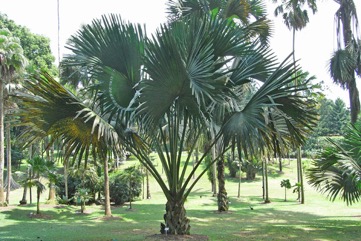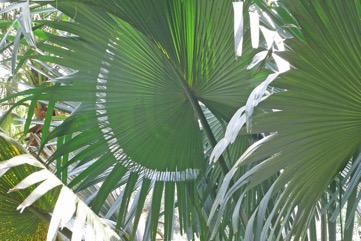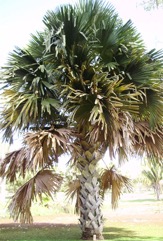Talipot palm, Great fan palm

A tropical plant. Once established plants can tolerate considerable dryness. It grows best in tropical zones. It can grow on most soils but needs good drainage. In Sri Lanka it grows below 800 m above sea level. It suits hardiness zones 10-12. In XTBG Yunnan. In Townsville palmetum.
Also known as:
Bajar-battuler, Bajarbattu, Buri palm, Dridhatalamu, Gebang palm, Gewang, Karalika, Khai, Kudaippanai, Kudappana, La:n, Laang-mueng-theong, Lan, Latanier, Palem gebang, Pe-bin, Pu ti gen, Sritalam, Sritalamu, Sritale, Tala gas, Tali-pannai, Tali, Talippana, Tarit, Thalapanai, Tuli
Synonyms
- Bessia sanguinolenta Raf.
Edible Portion
- Kernels, Starch, Sap, Cabbage, Sago, Nuts, Palm heart
Where does Talipot palm grow?
Found in: Andamans, Asia, Australia, Bangladesh, China, India, Indochina, Indonesia, Laos, Myanmar, SE Asia, South America, Sri Lanka, Thailand, Venezuela, Vietnam
Notes: There are 8 Corypha species.
Growing Talipot palm, Great fan palm
Cultivation: Plants can be grown from seeds.
Edible Uses: Starch is extracted from the stem. This needs to be done before flowering. The sap is used to make fermented drinks. The palm cabbage is edible. It needs to be cut before flowering as it later becomes bitter.
Production: Plants are very slow growing.
Nutrition Info
per 100g edible portion| Edible Part | Energy (kcal) | Protein (g) | Iron (mg) | Vitamin A (ug) | Vitamin c (mg) | Zinc (mg) | % Water |
|---|---|---|---|---|---|---|---|
| - | - | - | - | - | - |
Talipot palm, Great fan palm Photos



References
Ali, A. M. S., 2005, Homegardens in Smallholder Farming Systems: Examples from Bangladesh. Human Ecology, Vol. 33, No. 2 pp. 245-270
Ambasta, S.P. (Ed.), 2000, The Useful Plants of India. CSIR India. p 142
Anderson, E. F., 1993, Plants and people of the Golden Triangle. Dioscorides Press. p 207
Ashton, M. S., et al 1997, A Field Guide to the Common Trees and Shrubs of Sri Lanka. WHT Publications Ltd. p 80
Balick, M.J. and Beck, H.T., (Ed.), 1990, Useful palms of the World. A Synoptic Bibliography. Colombia p 121, 199, 273, 292, 404,
Blomberry, A. & Rodd, T., 1982, Palms. An informative practical guide. Angus & Robertson. p 93
Brickell, C. (Ed.), 1999, The Royal Horticultural Society A-Z Encyclopedia of Garden Plants. Convent Garden Books. p 305
Cundall, P., (ed.), 2004, Gardening Australia: flora: the gardener's bible. ABC Books. p 424
Gibbons, M., 1993, Palms. Compact study Guide and Identifier. Sandstone. p 37
Gibbons, M., 2003, A pocket guide to Palms. Chartwell Books. p 92
Heywood, V.H., Brummitt, R.K., Culham, A., and Seberg, O., 2007, Flowering Plant Families of the World. Royal Botanical Gardens, Kew. p 348
Johnson, D.V., 1998, Tropical palms. Non-wood Forest products 10. FAO Rome. p 40, 122
Jones, D.L., 1994, Palms throughout the World. Smithtonian Institution, Washington. p 51, 202
Jones, D.L., 2000, Palms of Australia 3rd edition. Reed/New Holland. p 150
Llamas, K.A., 2003, Tropical Flowering Plants. Timber Press. p 102
Marinelli, J. (Ed), 2004, Plant. DK. p 365
Menninger, E.A., 1977, Edible Nuts of the World. Horticultural Books. Florida p 132
PROSEA handbook Volume 9 Plants yielding non-seed carbohydrates. p 169
Purseglove, J.W., 1972, Tropical Crops. Monocotyledons. Longmans p 423
Rajapaksha, U., 1998, Traditional Food Plants in Sri Lanka. HARTI, Sri Lanka. p 367
Riffle, R.L. & Craft, P., 2003, An Encyclopedia of Cultivated Palms. Timber Press. p 315
Sahni, K.C., 2000, The Book of Indian Trees. Bombay Natural History Society. Oxford. p 181
Sp. pl. 2:1187. 1753
Sukarya, D. G., (Ed.) 2013, 3,500 Plant Species of the Botanic Gardens of Indonesia. LIPI p 773
WATT,
World Checklist of Useful Plant Species 2020. Royal Botanic Gardens, Kew
www.ethnobiomed.com